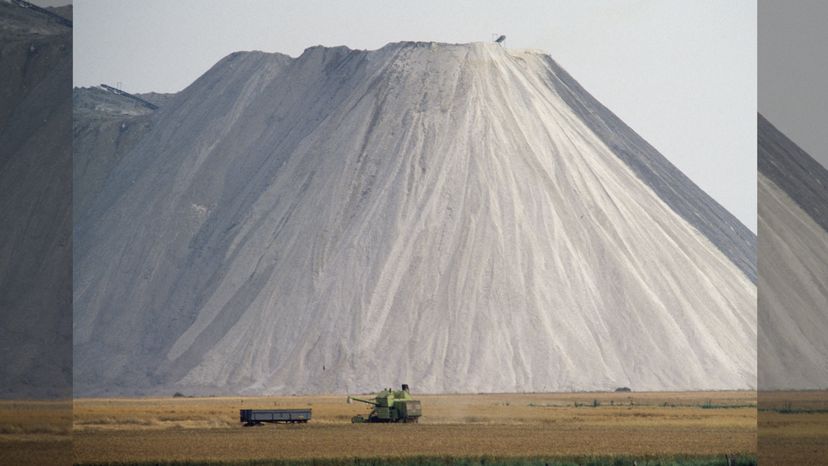
It's very likely that at this point in your life, you've heard about the chemical element phosphorus. It's arguably one of the more famous, and with good reason: It's the 11th most common element on Earth, and the second most common in the human body. And like all chemical elements, phosphorus can be found in a few different forms, just like you can turn corn into grits or tortillas or creamed corn. But arguably the most useful form of phosphorus, as far as living things are concerned, is phosphates (singular: phosphate), which, simply put, are chemical compounds containing phosphorus. Here are four things to know about phosphates:
1. Phosphates Are Everywhere
Phosphorus shows up in nature as phosphate (PO43-), and there's very little phosphates can't do, from cleaning your house to storing energy in your cells. Phosphates can be found in your toothpaste, your bones, table salt, fire extinguishers, your DNA, yoga mats, snack cakes — you name something, it probably contains some form of phosphate.
Advertisem*nt
"'Phosphates' is a broad term that describes any chemical containing a group of linked oxygen and phosphorus atoms," says Erin Shanle, a biology professor at Longwood University. "Phosphates are found on many chemicals, including detergents and fertilizers, and molecules in our bodies such as DNA and proteins. Phosphates can also be found in many other personal and household products."
2. Phosphates Work Overtime in Your Body
Phosphates are found in all living things — your body could get very little done without them. Phosphates are the workhorses that build molecules like DNA, transfer energy and transport molecules in and out of cells, and activate and inactivate proteins. But we also require phosphates to build strong bones: In vertebrates, approximately 85 percent of the body's phosphorus is found in bones and teeth. If you don't get enough phosphorus in your diet, your bones can become brittle.
"We often hear that calcium is used in bones — drink your milk to get strong bones! — but phosphates are just as important as calcium," says Shanle. "In fact, most of the phosphate in your body is found in your bones and teeth."
Most of us get an abundant amount of phosphorus in our diet — meat is rich in phosphorus, as are dairy, soy, beans, eggs and nuts.
Although phosphorus is essential in the body, people with chronic kidney disease have a problem removing excess phosphorus from the body. In these cases, too much phosphorus can actually be toxic.
Advertisem*nt
3. We Need Phosphates to Feed Us
Food production requires a lot of phosphorus (in addition to the other essential nutrients, nitrogen and potassium). Although phosphorus can't be synthesized or manufactured, virtually all the phosphorus that started out on this planet remains here to this day — all the plants and animals that use it poop it right back out when they're done with it.
It's inconvenient, though, to wait around for animals to poop and plants to drop all their leaves in order to access the phosphorus needed to feed Earth's 7.5 billion people. Which is why we mine phosphorus in the form of phosphate rock, formed over millions of years by the bones and poo of ancient animals floating to the bottom of primeval seas. Ninety percent of the phosphate rock we mine today is used to make fertilizers for agriculture and food production. Phosphate rock is mined in the United States (mainly the State of Florida, which was underwater until not so long ago, geologically speaking), Canada, Brazil, Russia, South Africa and Zimbabwe.
Advertisem*nt
4. Too Much Phosphate Can Lead to Big Environmental Problems
In the environment, phosphorus is essential for plants and other organisms to go about their business, but excess phosphate can cause major problems in freshwater environments like rivers, streams and lakes.
"Phosphorus is one of the main ingredients in fertilizers because it helps plants grow more quickly and increases crop yields," says Shanle. "When excess phosphorus washes off fertilized lawns or fields, it begins to build up in lakes, rivers, and other aquatic systems. This provides a rich food source for algae, which will make water cloudy and remove all of the oxygen from the water. This process, known as eutrophication, kills fish and other life in the lakes or rivers. Because of this, it is important that we minimize the amount of phosphorus we release to aquatic systems. There are efforts to reduce the amount of phosphorus-containing fertilizers that are widely applied."
So, next time you're shopping for detergent, pick the phosphate-free option to help save fish and other marine life.
Now That's Interesting
Most sodas contain quite a bit of phosphate in the form of phosphoric acid, which acts as a preservative.
Advertisem*nt
Frequently Answered Questions
What does it mean if your phosphate levels are high?
High phosphate levels in the blood can be a sign of kidney disease.
